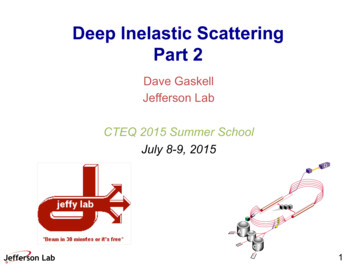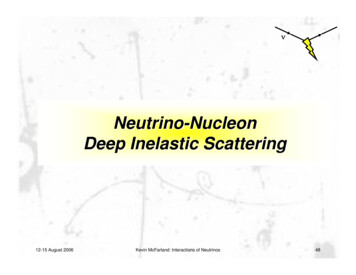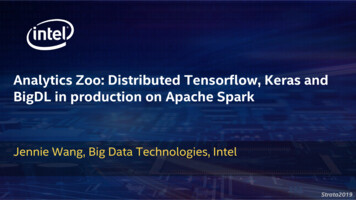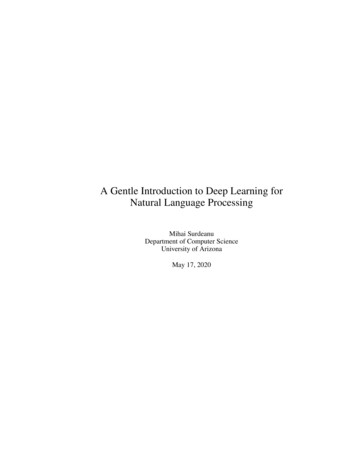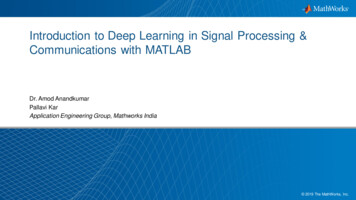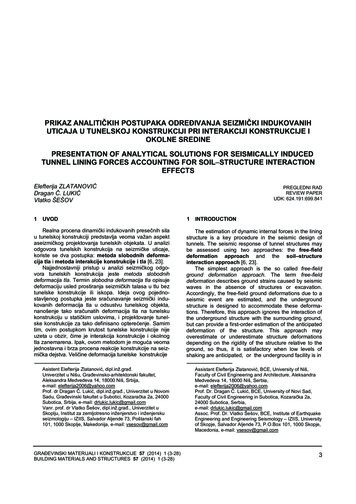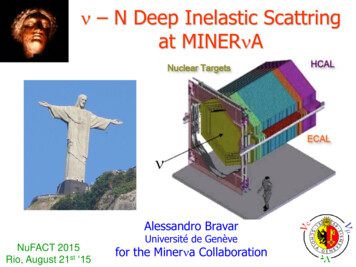
Transcription
n – N Deep Inelastic Scattringat MINERnAAlessandro BravarNuFACT 2015Rio, August 21st ‘15Université de Genèvefor the Minerna Collaboration
The MINERnA DetectorMINERnA, NIM A743 (2014) 130120 plastic fine-grained scintillator modules stacked along the beam directionfor tracking and calorimetry ( 32k readout channels with MAPMTs)MINOS Near Detector serves as muon spectrometer (limited acceptance)nuclear targets: He, C, H20, Fe, Pbin the same neutrino beamfully active scintillator tracker(x/v and x/u modules)
Detector Technologytriangular scint. barswith WLS fiberand MAPMT readoutAnother Module16.7 mmOne Module17 mmCharge sharing for improved positionresolution ( 3 mm) and alignmentσ 3 mmScintillator - trackingLead - EM calorimetrySteel - hadronic calorimetry
Nuclear TargetsActive Scintillator ModulesLiquid He250 kgWaterHe1” Fe / 1” Pb322 kg / 263 kg“1”1” Pb / 1” Fe263 kg / 321 kg“2”3” C / 1” Fe / 1” Pb160 kg / 158 kg / 107 kg“3”9” H20625 kgTrackingRegion0.3” Pb225 kg.5” Fe / .5” Pb162 kg / 134 kg“4”“5”
Probing Nucleon Structure with Neutrinosneutrinos – weak probe of nuclear (low E) and hadronic (high E) structureCharged lepton scattering data show that quark distributions are modifiedin nucleons confined (bound) in a nucleus (EMC effect, shadowing at low x, )PDFs of a nucleon within a nucleus are different from PDFs of a free nucleonn probes same quark flavors as charged leptons but with different “weights”n’s also sensitive to axial piece of F2n’s sensitive to xF3 expect different shape ? expect different behavior ? x 1? is shadowing the same ?Nuclear effects in neutrino scattering are not well established, and have not beenmeasured directlyexperimental results to date have all involved one target material per experiment(Fe or Pb or )MINERnA attempts a systematic study of these effects using different A targetsin the same detector exposed to the same neutrino beam
What Have We Observed with EM Probes ?Bodek-Yang Model (2003)for nuclear modificationsarXiv:hep-ex/0308007(Neutrino event generators rely onmeasurements from charged leptons)Fit to charged lepton dataA / D Ratio (e / m DIS)F2A / F2DQ2xBj 2MEhadFermi motionAll nuclei has same modificationAll treated as isoscalar ironanti-shadowingshadowingEMC effectxBjThe EMC effect (valence region) does notshows a strong A dependence for F2A / F2DNuclear modification fitfor iron to deuterium ratio
CTEQ Predictions for MINERnAGeneral strategy has been to adapt electronscattering effects into neutrino scatteringtheoryNeutrino event generators rely onmeasurements from charged leptonsCTEQ tries to fit for nuclear effects bycomparing NuTeV structure functionson iron to predicted “n p” structurefunctions and comparing to predictionsfrom charged lepton effects:- charged lepton fit undershootslow x n data & overshoots mid x n data- low Q2 and low x n data cause tensionwith the shadowing observed in chargedlepton dataCTEQ prediction for the structure functionratios MINERnA can measure5% to 10% effects predicted for Pb / CShould be also studied using D targets.Kovarik PRL106 (2011) 122301
n -sectionsMINERnA measures n – N interactions in the transition regionfrom exclusive states to DISFormaggio & Zaller, RMP 84 (2012) 1307nnlarge Q2elasticincreasing En, Q2inelastic
The NUMI Beam (Fermilab)NuMI (Neutrinos at the Main Injector)120 GeV protons from Main Injector, 350 kW90 cm graphite target675 m decay tunnelBy moving the production target w.r.t. 1st horn andchanging the distance between the horns one canmodify the n spectrum:LE (peak 3 GeV) ME (peak 6 GeV)Flux determinationexternal hadron production datan – e elastic scatteringlow–n extrapolationmuon monitor dataspecial runs (vary beam parameters)
n – e elastic scatteringneutrino – electron elastic scattering is the only “standard candle” in neutrino scattering(in situ flux measurement)nmnmn e- n e- candidateee- candidateZ0ennevery forward single electron final statesignalEq2 2meEq2 2me 100 events in LE sample 10% flux constraint (expect 5% precision in ME)
NuMI Low Energy Beam, FTFP6flux (neutrino s / m2 / GeV / 10 POT)Collected Data120hadron productioncorrected fluxnmnm10080604020002468101214neutrino energy (GeV)1.5 – 10 GeVLow Energy (LE, peak 3 GeV) run2010 – 2012LE n mode3.9 x 1020 POTLE anti-n mode 1.7 x 1020 POTflux-calibration 4.9 x 1019 POTMedium Energy (ME, peak 6 GeV) runstarted in fall 2013already 6 x 1020 POT161820
Event Selection and ReconstructionCnm N m- XStrip NumberFe Pbprimary m trackMINOS NDmatched trackvertexrecoil energy Ehad :additional hits are summed upto measure Ehad calorimetricallyModule NumberEvent selection criteria:single muon track in MINERnA, well reconstructed and matched into MINOS ND“standard cuts”: 2 En 20 GeV & qm 170 (MINOS ND acceptance)CH2: reconstructed vertex inside fiducial tracker regionnuclear targets: z position of vertex consistent with nuclear targetrecoil energy Erecoil reconstructed calorimetrically incoming neutrino energy En: En Em Erecoil
Recoil Energyrecoil energy Erecoil reconstructed calorimetrically:calorimetric Erecoil i ci Eisum of visible energy, weighted by amount of passive materialMINERvA detector's hadronic energy response is measured using a dedicatedtest beam experiment at the Fermilab Test Beam Facility (FTFB)p / p / p- response measured with uncertainty 5%MINERnA, NIM A789 (2015) 28pp Hadronic energy reconstruction uncertaintyestimated from difference betweentest beam data and GEANT MC.
“Plastic” BackgroundProject the one track events to thepassive target’s center in zThis is the best guess of the vertexScintillator events wrongly accepted intopassive target sample are backgroundTgt2Tgt3Tgt5Tgt4background : these peaksare at the location of thefirst module downstreamof the passive targetsuse downstream trackermodules to predict andsubtract the“plastic background”
Inclusive Cross Section Ratios – ds / xTice, PRL 112 (2014) 231801Reconstructed x (no correction for detector smearing)Taking ratios removes uncertainties due to the neutrino flux, acceptance, At low x, x 0.1, observe a deficit that increases with the size of the nucleus(possibly additional nuclear shadowing in n scattering, study more directly in DIS)At high x, x 0.7, observe an excess that grows with the size of the nucleus(events are dominated by CCQE and resonances)These effects are not reproduced by current neutrino interaction modelsGENIE assumes an x dependent effect from charged lepton scattering on nucleibut n sensitive to xF3 and also to the axial part of F2When studied as a function of En:no evidence of tension between MINERnA data and GENIE 2.6.2 simulations
W – Q2 Kinematical Region in LESelect DIS sample by requiring Q2 1.0 GeV2 and W 2.0 GeV(these cuts remove the quasi-elastic and resonant “background”)z axis : 103 events / 3 x 103 kg of C / 5e20POTSimulationGENIE 2.6.2kinematical distributions from GENIE v2.6.2 simulationevents shown have muon tracked in MINOS
From Inclusive to DISSelect DIS sample by requiring Q2 1.0 GeV2 and W 2.0 GeVThese cuts remove the quasi-elastic and resonant events form the inclusive sample,and allow us to interpret our data on the partonic level.Cuts are illustrated for CH events between 5 En 50 GeV and qm 170preliminarypreliminaryAfter making kinematic cuts on Q2 and W, we are left with a background of eventswith true Q2 1.0 GeV2 and W 2.0 GeV that smear into the sampleEstimate this background in the nuclear targets and scintillator using MCtuned to data using events adjacent to W 2 GeV and Q2 1 GeV2
Hadronic Energy ResolutionHadronic energy reconstructed for DIS interactions on different “targets” (x arydownstreamAccuracy of high-energy, low x hadronic showers reconstructionis very similar between nuclear targets and tracker moduleswith a resolution s 20 %Simulation adequately accounts for the different detector geometry and compositionseen by hadronic showers, regardless of where the interactions originate
DIS Sample (En)DIS sample: Q2 1.0 GeV2 and W 2.0 GeV5 En 50 GeV and qm 170Carbon targetData events reconstructed in C,with non-DIS events subtractedpreliminarySimulated DIS events,reconstructed in CCH events in scintillatorsurrounding target,with non-DIS events subtractedSubtract these CH eventsto obtain a sample of DISon C in data and MC
DIS Cross Section Ratios – s (En)J. Mousseau, �CH/dxDIS cross section ratios on C, Fe, and Pbcompared to CH as a function of EnpreliminarydσPb/dx“Simulation” based on nuclear effectsobserved with electromagnetic probesRatios of the heavy nuclei to lighter CHare evidence of nuclear effectsdσCH/dxObserve no neutrino energy dependentnuclear effect
DIS Cross Section Ratios – ds / dxBjJ. Mousseau, �CH/dxUnfolded x (detector smearing)DIS: interpret data at partonic levelx dependent ratios directly translates tox dependent nuclear effectspreliminary(cannot reach the high-x with LE data sample)dσPb/dxdσCH/dxMINERnA data suggests additional nuclear shadowingin the lowest x bin ( x 0.07, Q2 2 GeV2)In EMC region (0.3 x 0.7) good agreementbetween data and models
Cross Section Ratios Uncertainties dxTaking ratios removes large uncertainties due to the neutrino fluxUncertainties similar across different targets, all targets in same beam flux largely cancels similar acceptance and reconstruction(however efficiency correction introduces cross section model uncertainties)Most of the uncertainty stems from data statistics(higher intensity, higher energy ME beam will improve this substantially)“Plastic” background subtraction introduces a larger uncertainty in x (not in En)Current errors allow to observe 10 % nuclear effects
ProspectsforDISwithMEBeams22–Q “acceptance”2LE (010 –12) W–Q “acceptance” 2ME (013EEW – Q2 KinematicalLEandMEz axis :Region10 events / 3inx 10kg ofC / 5e20POT33–18)z axis : 103 events / 3 x 103 kg of C / 6z axis : 103 events / 3 x 103 kg of C / 5e20 POTSimulationGENIE 2.6.2SimulationGENIE 2.6.2DISRESCCQELEmatical distribution from GENIE 2.6.2 event generatorMiner a “standard” cuts ( 2 GeV, 170)MEkinematical distribution from GENIE 2.6.2 event generator 170)Many more neutrino interactions in DISregimewith Minera “standard” cuts ( 2 GeV, increased statistics (beam intensity, energy) improve on systematical uncertainties structure function measurements on different nuclei probe quark flavor dependence of nuclear effectsRequested 10 x 1020 POT in neutrino and12 x 1020 POT in antineutrino mode
ConclusionsMINERnA attempts a systematic study of nuclear medium modifications andhadronic structure using different nuclear targets in the same detector exposedto the same neutrino beamFirst measurement of ratios of neutrino cross sections on different nucleiin the DIS regimeThese measurements may be interpreted directly as x dependent nuclear effectsObserve no significant En dependences compared to theoryIn the EMC region (0.3 x 0.7) good agreement between data and models(GENIE assumes an x dependent effect from charged lepton scattering on nuclei)MINERnA data suggests additional nuclear shadowing in the lowest x bin( x 0.07, Q2 2 GeV2)Data taking with a “Medium Energy” n beam started in fall 2013En peak 6 GeV, already more POT (6 x 1020) than LE data takingThe higher neutrino beam energy allow us to access the DIS region andstudy quark distributions over a broad xBj rangeIncreased statistics gives nuclear target ratios for all interactions
The MINERnA Collaboration 65 collaborators (from nucl. and part. physics) 20 institutionsCentro Brasileiro de Pesquisas Físicas, Rio de Janeiro, BrazilUC Irvine, Irvine, CAUniversity of Chicago, Chicago, ILFermi National Accelerator Laboratory, Batavia, ILUniversity of Florida, Gainsville, ILUniversité de Genève, Genève, SwitzerlandUniversidad de Guanajuato, Ganajuato, MexicoHampton University, Hampton, VAMass. Col. Lib. Arts, North Adams, MAUniversity of Minnesota-Duluth, Duluth, MNNorthwestern University, Evanston, ILOregon State University, Portland, OROtterbein College, Westerville, OHUniversity of Pittsburgh, Pittsburgh, PAPontificia Universidad Católica del Perú, Lima, PeruUniversity of Rochester, Rochester, NYRutgers University, Piscataway, NJUniversidad Técnica Federico Santa María, Valparaiso, ChileTufts University; Medford, MAUniversidad Nacional de Ingeniería, Lima, PeruCollege of William & Mary, Williamsburg, VA
EMC effect Fermi motion The EMC effect (valence region) does not shows a strong A dependence for F 2 A / F 2 D 2 Bj 2 had Q x ME Nuclear modification fit for iron to deuterium ratio Bodek-Yang Model (2003) for nuclear modifications arXiv:hep-ex/0308007 (Neutrino event generators rely on meas
